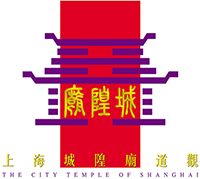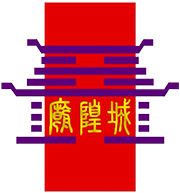- 现在,您正在上海城隍庙的大门附近。庙观的大门,通常称为“山门”。城隍庙的山门是在明朝嘉靖十四年(1535年)建造的,已经有四百五十年以上的历史了。山门的柱子是石柱,山门的横梁是木材制作的。上面有四个金色大字“保障海隅”,原来是由明代上海县知县冯彬题写的。现在你见到的字是在1994年上海城隍庙恢复开放的时候,根据历史照片重新书写的。保障海隅就是保护上海的意思。山门前面有二个石狮子,也有几百年的历史了,被来庙烧香的香客用手摩的精光铮亮。据说,手摩石狮子可以带来平安和福气。
- 山门前面原来是一个广场,清代末年建造的方浜中路在山门前通过。在庙门的对面有个照壁。照壁前面还有二根旗杆。旗杆上平时挂着“国泰民安”、“风调雨顺”的旗帜。在旗杆前面就是照壁。照壁是用青灰色的青砖雕刻而成的。对着大门的一面中间是一只神兽的图样。这只神兽名字叫“X”,它的形状很像另外一种神兽“麒麟”。独角、马蹄、浑身长满鱼鳞。“×”作为神兽能够吃掉各种邪恶的东西,后来因为吃得多了,越吃越贪,就吃尽了各种珍珠宝贝。可是它还不满足,就想吃掉天上的太阳。结果就在奔向太阳的路上,掉进了永世不得翻身的谷底。照壁上塑造“×”这个形象,就是告诫到城隍庙来的人,人生在世不能贪得无厌。欲望是万恶之源。
- 照壁的另外一面雕刻着三只羊,羊和“阳”是谐音。三只羊就是“三阳开泰”的意思。三阳开泰原来是易的卦象,意思是阳气生长,阴气渐消,冬去春来,生活和事业都越来越好。
技术支持 奥谷信息技术 ( 上海 ) 有限公司 / Support by: aoGUU Information Technology
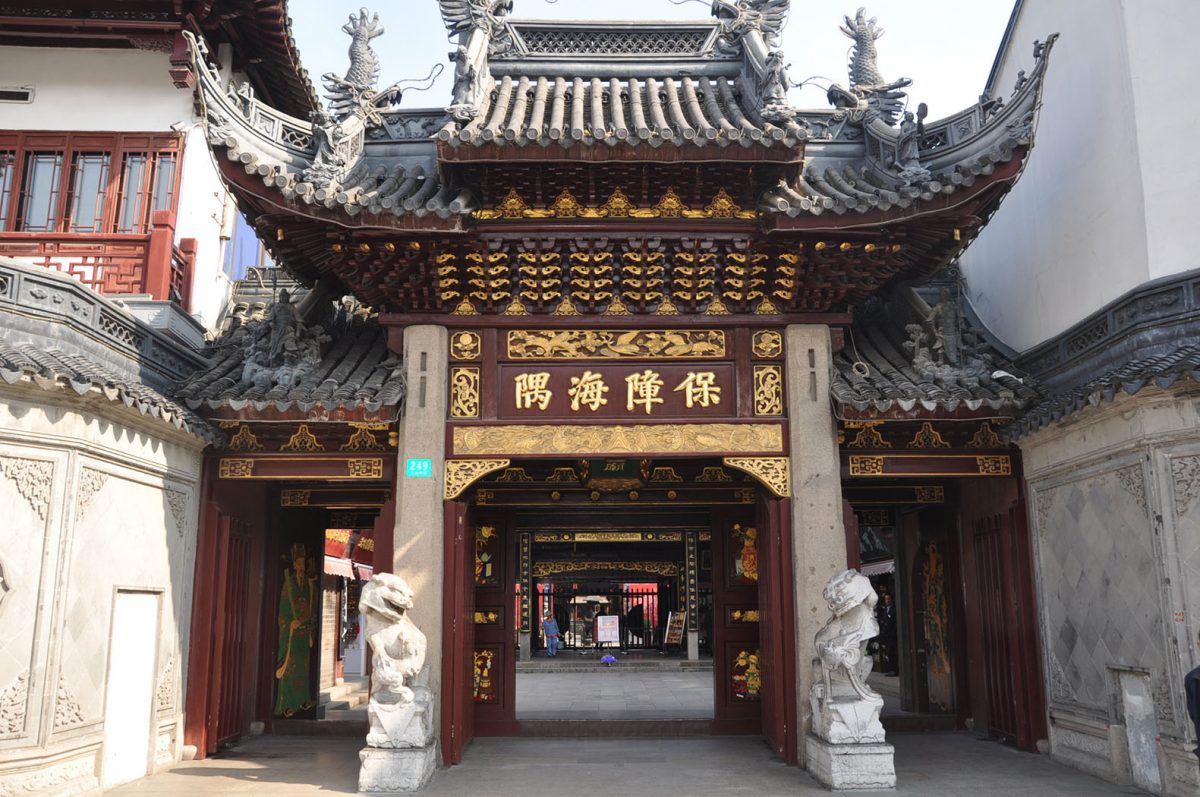
Mountain Gate
- Now, you are at the front gate of the Shanghai City God Temple. The front gate of temple is often called “Mountain Gate”, as the early Taoist hermits built their chapels in the mountain in order to live a life of tranquility and taciturnity. City God Temple’s mountain gate was built in 1535, the 14th year of Emperor Jia-jing’s reign during Ming Dynasty, thus today it enjoys a history of more than 450 years. The structure of mountain gate consists of stone pillars and timber beams. The four golden characters up the gate read “to protect the coastline”, which actually means to protect Shanghai. The characters were originally written by Shanghai county sheriff Fengbin in the Ming Dynasty; however, what you see today is a reproduction based on historical pictures, created in 1994 from which time the City God Temple has once again been open to the public. The two stone lions in front of the mountain gate also have a history of hundreds of years. People believe that patting their heads will bring peace and luck. After being touched by thousands and thousands of visitors, you can see their bodies are very shiny now.
- There used to be a square in front of the mountain gate, Fangbang Middle Road built in the last few years of the Qing Dynasty- used to run through the gate. To the opposite side of the temple gate, there is the screen wall with two flagpoles in the front. Normally we have flags with writings that pray for the peace of the people and for propitious weather that promises a harvest. The screen wall is made of steel gray bricks. On the side to the gate, there’s the picture of a sacred animal, whose name is “Tan”. With a single horn, horse hooves and fish scales, it looks like another kind of sacred nimal “Qilin”. As a sacred animal, “Tan” could eat all kinds of evil, but then it ate too much and became greedy, and began eating pearls and gems. Still hungry, the animal wanted to eat the sun in the sky. On the way in pursuit of the sun, it dropped into s deep valley and could never get out again. The picture of “Tan” on the screen wall warns visitors to the City God Temple that greed is the source of all evil.
- There are three goats on the other side of the screen wall. “Goat” in Mandarin sounds the same as “Yang” which has a positive connotation and is the opposite to the negative “Yin”. “Three goats” refers to “Triple Yang that Brings Prosperity” from I-Ching, the Book of Changes, as one of the 64 diagrams which refer to prophetic implications to the universe. And this diagram here means the Yang, or the positive power is waxing, while the Yin, or the negative power, is waning. Winter has gone and spring is on the way. People’ lives and careers are getting better.
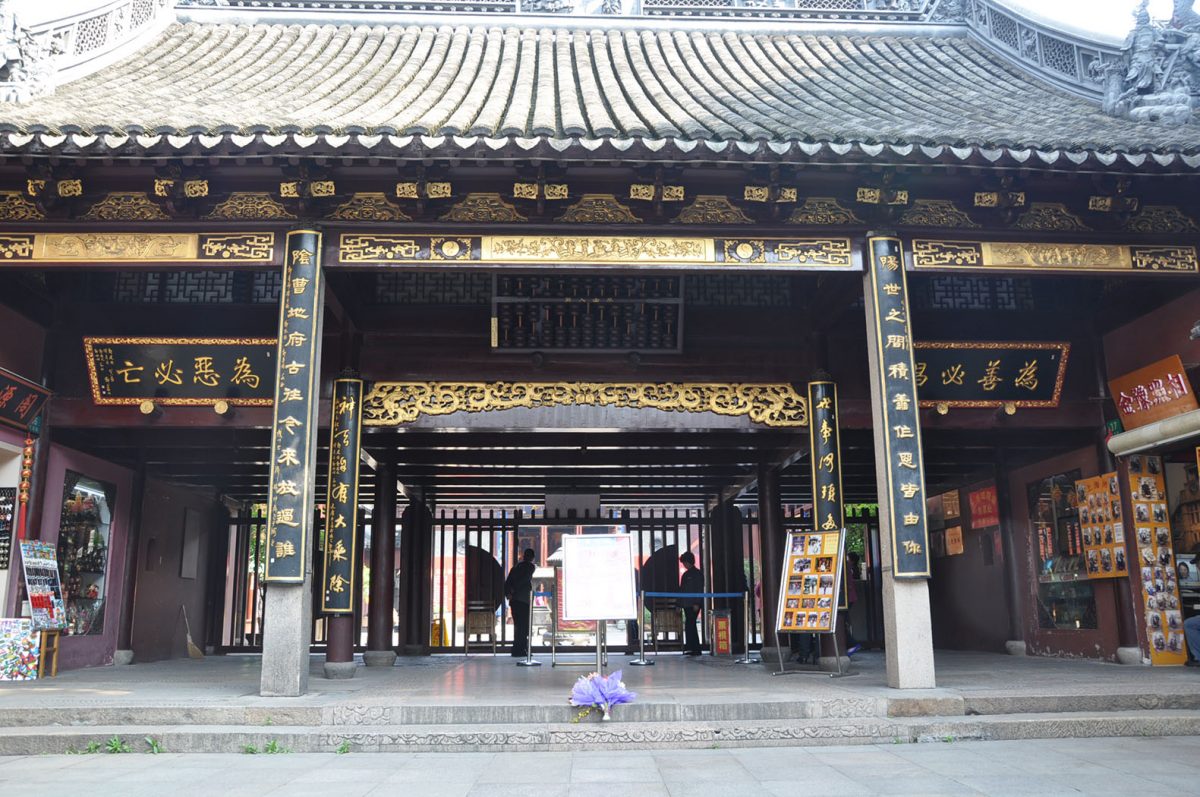
现在,你进入了上海城隍庙的山门,前面又是一道门,称为“仪门”。仪门是过去官衙的第二道正门。仪门前面有二副对联。
上联是:阳世之间积善作恶皆由你;
下联是:阴曹地府古往今来放过谁。
- 这副对联的意思就是,在阳世,你生活中,做好事或者做坏事,都是由你自己决定的。可是人死后到了阴间,地狱的官府从古到今,从来不会放过要惩罚的坏人。
另一副对联
上联是:世事何须多计较;
下联是:神界自有大乘除。
- 这副对联的意思就是,人生在世,碰到各种吃亏或沾便宜的事情,你不必多加计较。因为,神灵对于人的善良和罪恶都会加以回报或清算的。
- 请注意在对联的后面挂着一只很大的算盘,算盘上刻着四个字“不由人算”,算盘上的算珠有上有下,象征神界正在进行“大乘除”。算盘的旁边立了二块巨额。巨额上写的是:为善者昌,为恶者亡。意思是:做好事的人,在神界计算中一定会兴旺发达;做坏事的人,在神界计算中一定会衰败灭亡。
- 城隍庙挂大算盘是有深刻含义的。它一方面告诉信众,做人要淡泊名利,不要自私自利,不要斤斤计较。因为,人有算计,天有算计,人算总不如天算。过分计较的结果会自食其果。另一方面又是告示天下,天算就是天道,天道自有规律,任何人只有循天道而行才有善终,逆天道而行必然自取灭亡。
Yi Men
- Now, you have entered the mountain gate of the City God Temple gate, There is another gate in front of you, its name is “Yi Men”, meaning “ceremonial gate”. In the past, this of. This “ceremonial gate” was the second front gate of a government office court, in this case the ancient architects borrowed the element of an office court into Temple as the office of gods. You can see two couplets in front of Yi Men.
- The first couplets reads:
- To do good or to do evil, that is all up to you in the world of the living;
- From the past to the present, no one escapes judgment in the world of the dead.
- City God in Taoism is a group deities at low ranking who protects the city and its people, and also in charge of the residential registration of all the souls and spirit in the area; therefore City God is the first deity whom a spirit has to visits on the way to judgment in the afterlife once a person’s soul leaves the body after death, and the Temple of City God is always a popular venue to educate the notion of comeuppance.
- Another couplet reads:
- What you gained, what lost, there’s no need to calculate;
- Who has done good, who evil, the gods keep the records.
- Taoism believes that Tao is everywhere, and the gods from Tao are everywhere for staking out and making records of all the people for their behaviors, there are even the spirits inside everyone’s body for watching one’s mind, language and behavior, in the judgment in hell, all the records would be referred to.
- Behind the couplets, note that there’s large abacus with words “It’s not up to people to calculate.” Some of the beads are up, some are down, which means the gods are doing their calculations invisibly. Beside the abacus, there are two plaques. Together they read:
- People who have done good will prosper;
- People who have done evil will perish.
- The displaying of the big abacus in City God Temple embodies a profound meaning. On the one hand, it urges the believers to be selfless, because people, no matter how smart or greedy they are, can never beat Heavenly rules, which are derived from Tao. On the other hand, the abacus tells everyone that the Heaven has its way of doing things, which is also derived from Tao, one who acts against Tao is doomed.
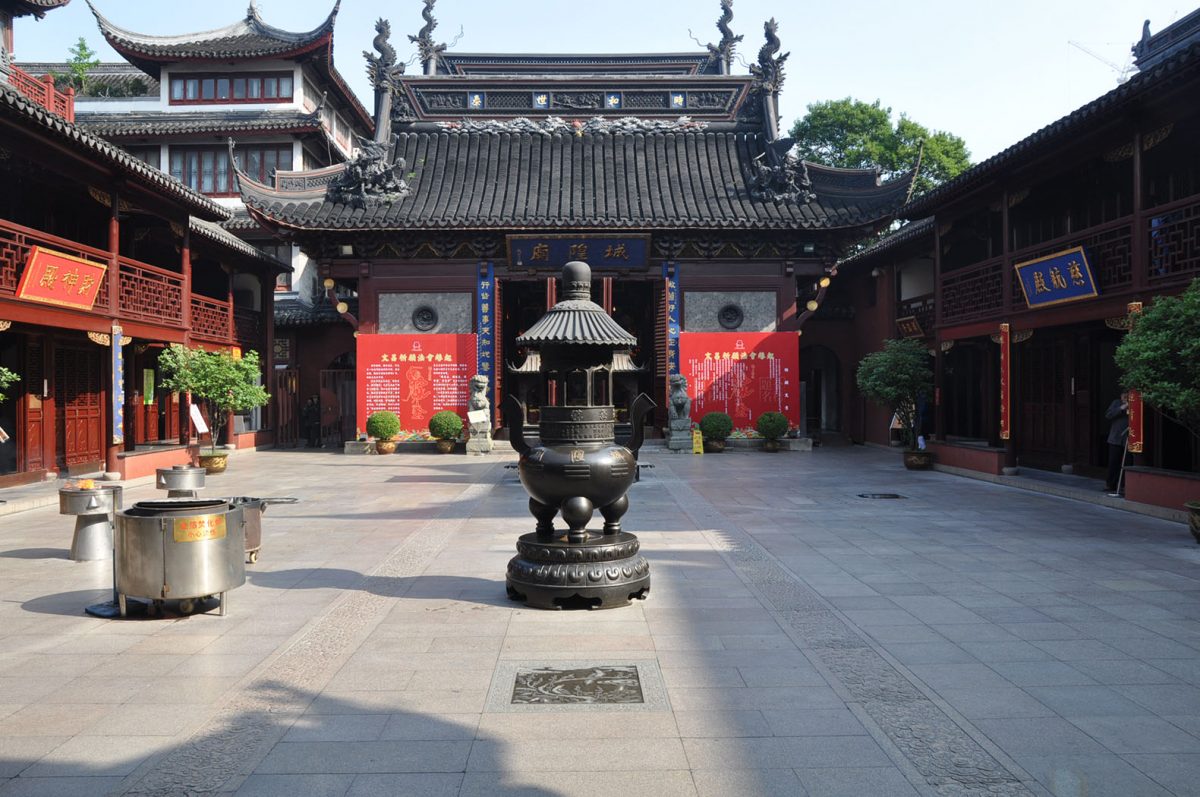
现在,您是在上海城隍庙大殿前的广场上。上海城隍庙是国内外著名的道教宫观和旅游胜地。
- 上海城隍庙,原名金山庙,即霍光行祠。大约是在明代永乐年间,也就是公元1403至
- 1424年间,当时的上海县知县张守约把金山神庙改为城隍庙。清代康熙时期,建造了东园。乾隆时期,又收购了西面的豫园。上海城隍庙最兴盛的时候,庙的面积曾经达到49.9亩,大约3万3千多平方米。清代中期,上海城隍庙周围就已经有了许多商店、酒楼、饭店、茶馆。上海城隍庙地区形成了把宗教、园林和商市汇集在一起的格局。
- 清代末年和民国时期,上海城隍庙曾经在战争中多次被军队占领,多次被烧毁。您现在看到的大殿是1926年重建的,整个建筑都是钢筋水泥,不过它的式样是仿照中国传统的庙宇式样。改革开放以后,中国的宗教信仰自由政策得到恢复和落实。1994年,上海城隍庙恢复由上海道教管理,恢复为道教活动场所。除了大殿,广场周围都是经过整修的建筑。
您的左面是财神殿,法物流通处,上海城隍庙宗教活动接待处。
您的右面是慈航殿,法物流通处,祈福堂。
您的背后是进庙的大门。这个大门原来是“仪门”,也就是二门。只是因为目前山门还没有收回,因此这里暂时作为大门。大门上面就是戏台。这个戏台平时是道士念经的经堂,在城隍神和城隍神夫人诞辰的日子,靠广场一边的木窗会拆除下来,变成一个戏台。戏台上演出的都是中国的戏剧。这些戏剧都是信众为了酬谢神灵的护佑、让神灵高兴而为神灵演出的。
The courtyard in front of the grand hall
Now you are at the courtyard in front of the grand hall.
As a Taoist temple and a tourist attraction, the City God Temple is famous bothnationally and internationally.
Shanghai City God Temple, original name is Gold Mountain Temple, or Huo Guang Temple. In the reign of Emperor Yong Le of the Ming Dynasty- from year 1403 to 1424- the Shanghai sheriff Zhang Shuoyue changed its name to the City God Temple. The East Garden was built in the reign of Emperor Kang Xi of the Qing Dynasty; the West Garden namely the Yu Garden, meanwhile, was built in the reign of Emperor Qian Long of the Qing Dynasty. In the Temple’s most prosperous time, the Temple had an area of around 33000 square meters. When it came to mid-Qing Dynasty, the Temple had already had many shops, taverns, restaurants and tea houses around it. It amalgamated religion, horticulture, and business.
During the end of Qing Dynasty and the time of the Republic of China, the Temple has been occupied and burnt down by the army several times over. The grand hall you see now was built in 1926 with reinforced concrete in the formal style of a Chinese, traditional temple. When policies on the freedom of religion were implemented after the Chinese government went through reforms. The Temple was again in the hand of the Shanghai Taoist Association at 1994. Once again, it became a place for Taoist practices.
Save the Grand Hall, all the building around the courtyard have been renovated. On your left is the Wealth God Hall, the Religious Appliance Store and Ritual Services Reception Centre. On your right is the Cihang Hall, the Religious Appliance Store and the Chapel of Wishes.
Behind you is the “Ceremonial Gate”. Above the gate, there is an opera house, in which priests often stand whilst reciting scriptures. Nevertheless, when it’s the City God’s or his lady’s birthday, the priests would remove the windows near the courtyard, thus changing the room into a stage. People would perform Chinese operas to please the gods and thank them for their protection.

三官殿中供奉的是主管天上事务、地上事务和水中事务的神灵,号天官、地官和水官,合称三官。因为他们的诞辰分别为上元、中元、下元节,所以称他们为三元三官大帝。
中间的那位是天官,是主管天上事务的神仙,生日在农历的正月十五日,称为元宵节。他的主要职司是赐予人们幸福,“天官赐福”是美好的吉祥语。所以当他生日的时候,人们会张灯结彩地庆祝,称为元宵节、元夜,许多地方称为灯节。各式綵灯,加上丰富多样的娱 乐表演,是这个宗教节日的主要内容。它是中国民众最重要的狂欢节。
左边的这位是地官,主管地上和地下幽冥世界的事务,生日是农历七月十五日,称为中元节。他的职司是赦免罪过让人解脱,鬼魂得以改善处境,出离幽冥。中元节,在民间也是一个祭奠亡故亲人、对祖先表达尊崇与孝心的日子。
右面的这位是水官,是主管水界的事务,生日在农历十月十五,就是下元节。水官的职司是解厄,就是解除生活中的种种厄运、困难。
三官管理着人们生活空间的一切神圣事务,和人们的生命、生活紧密联系,社会生活乃至生命结束后的去向,都要脱离不了三官的管辖。所以遇到疑难,人们都会来三官殿祈祷,求得佑护。
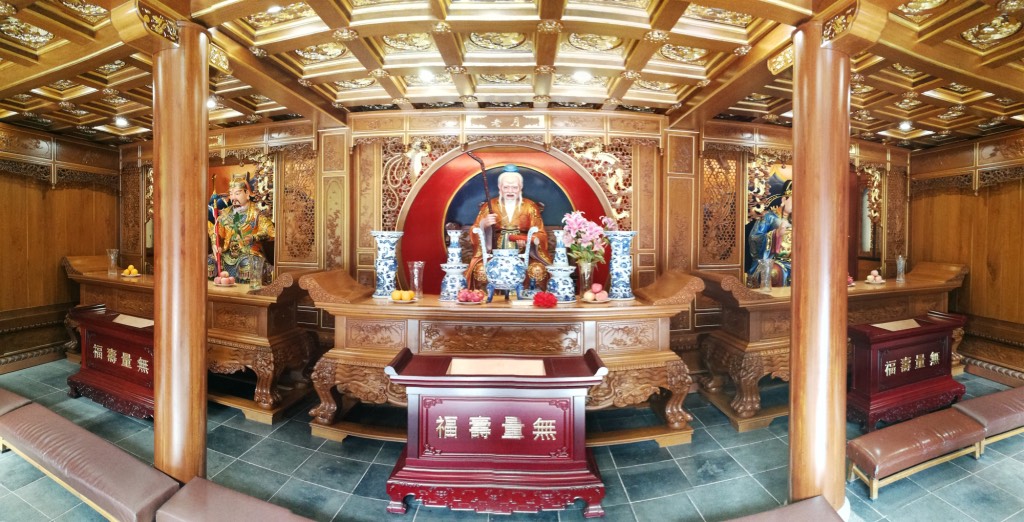
月老殿中供奉的是和人们生活美满、健康和平安密切相关的神。
中间的这位是月下老人,又叫月老。是专管爱情和婚姻的神。他经常在月光下查看《姻缘簿》,人们不知道他的名字,就称为“月下老人”。凡是有缘的人,从出生时起,月老就会用凡人看不见的红线系上他们的脚,那么即使经历千辛万苦,百般波折,最后也能终成眷属。人们祈求他指点自己的爱情归属和婚姻前景,保护爱情的纯洁和婚姻的稳固。他也本着“愿天下有情的人都成了眷属”的善良愿望,尽着自己的神圣职责。
右边这位是药王。他名孙思邈,南北朝至唐代初年人,是出名的长寿老人,活了一百多岁后才证道成仙。他医术高明,又充满着仁慈之心,人或是动物有病他都会救治。一次,他一条受伤的小青蛇,经过细心救护,挽回了生命。后来,海里的龙王来感谢他,愿意把龙宫里的珍宝让他任意挑选。原来救的小青蛇,是龙宫的太子。为了能提高医术,挽救更多的生命,孙思邈什么珍宝都不要,只要来了龙宫收藏的医书。他留下了许多医药著作,许多现在仍被奉为经典。他证道成仙后,骑着老虎去采药救人,小青龙就陪着他一起施医施药。
左侧的这位是车神。最早他担任路神一职,又称行神,是人们行走道路的保护神。后来,车辆成了路上来往的主要交通工具,他便成为车辆的保护神,他的职责是保佑车子运行的平稳安全,使车辆和其主人,逢凶化吉,如意安康。
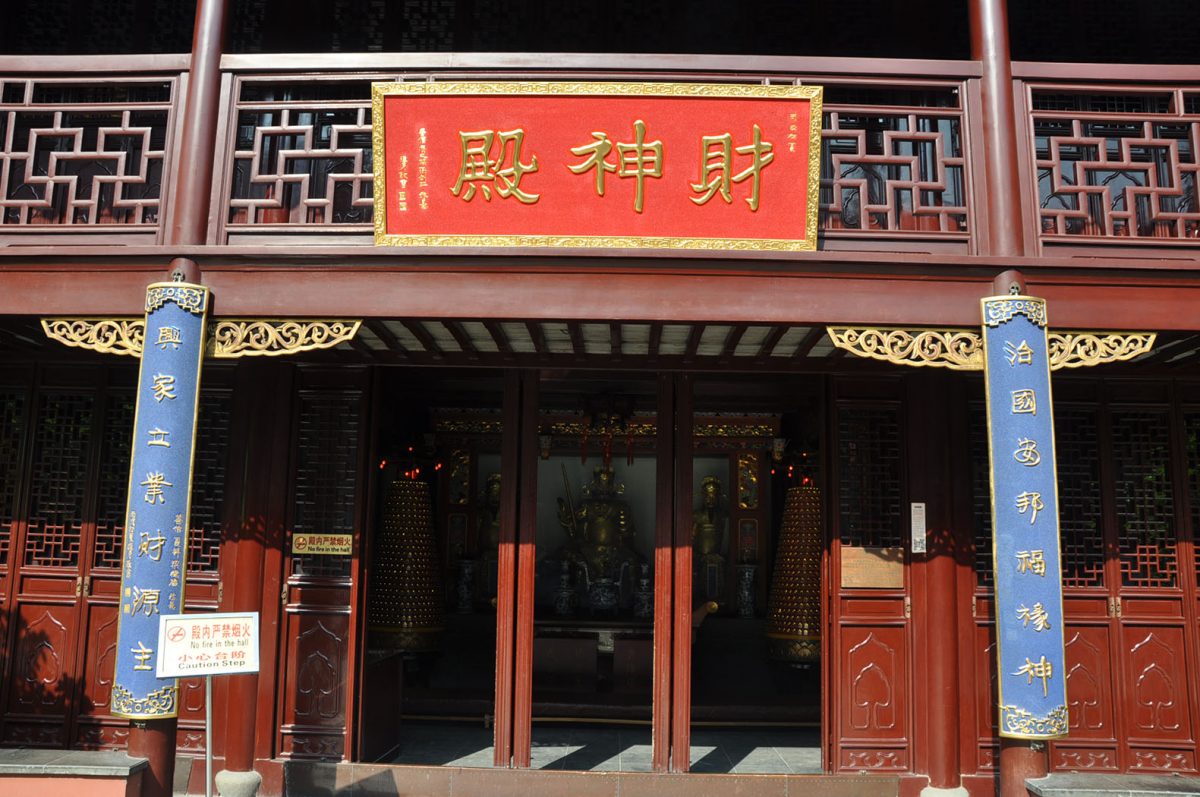
您的左面是财神殿。财神殿供奉的是财神。财神主管的是人的财富。财神殿门口有一副对联。上联是:兴家立业财源主。意思是:财神是您的发家致富、创立事业的财源的主宰。下联是:治国安邦福缘神。意思是:财神还是保佑国家平安稳定的有福的神灵。进入财神殿您可以看到供奉有五位财神。中间是赵元帅,就是赵公明。他的头上戴的是铁的帽子,一手拿着钢鞭,一手捧着元宝。黑色的脸,浓密的胡须,身下骑着黑色的老虎。全身是古代军人的装束。因为他掌管人间的公平买卖,和财富分配,能够使人发财,所以,信众供奉他为财神。
赵公明元帅的左面和右面是他的部下招宝天尊萧昇和纳珍天尊曹宝。这二位神灵都有招纳财富和珍宝的职能。在财神殿两边的是招财使者陈九公和利市仙官姚少司,他们都是掌管人间买卖的神灵,也是赵公明元帅的下属。
中国人在农历正月初五日要接财神,因此,在春节期间,财神殿总是挤满了来自四面八方的祭拜信众。
the Wealth God Hall
On your left, there is the Wealth God Hall. Wealth God manages people’s properties. The couplet on the gate reads:
Your household will flourish and your career will grow because of the wealth God;
Your country will prosper and your people will benefit because of the wealth God.
Going into the Wealth God Hall, you’ll see five wealth gods. The one in the middle is Marshal Zhao, whose full name is Zhao Gongming. He wears an iron helmet on his head, a whip in one hand and a shoe-shaped gold ingot in another. You can see his black face, bushy beard and his black tiger. Zhao is dressed in the manner of an ancient warrior. He protects fair trade and distributes wealth.
Left of Marshal Zhao is Xiao Sheng, the Treasure-Inducing God, and Cao Bao, the Treasure-Keeping God. Both of them are capable of accumulating wealth; on the sides of the hall are Messenger Chen Jiugong and Fairy Merchant Yao Shaosi. Both of these subordinates to Marshal Zhao deal with business in the human world.
It is said that January 5th of the Lunar Calendar is the day that Wealth Gods come to the earth to inspect people’s trade and bless people, and therefore this hall would be flooded on this day in the Spring Festival.
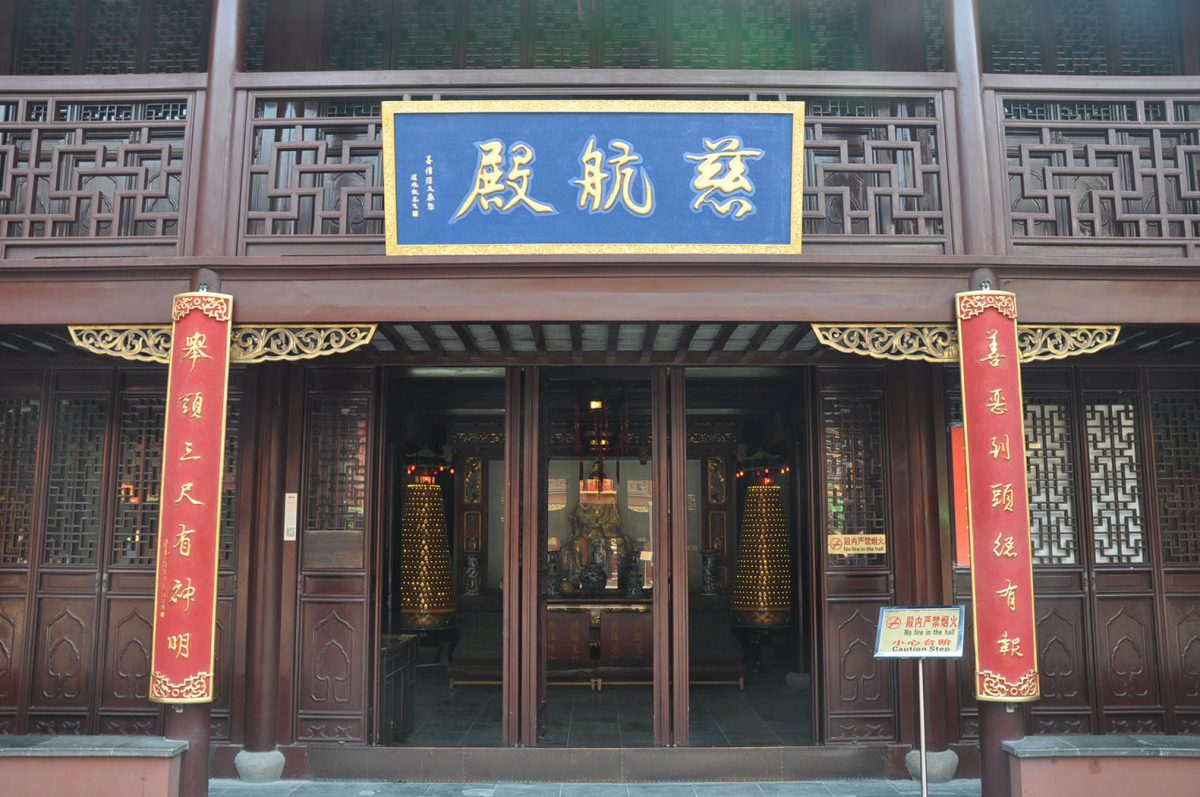
您的右面是慈航殿。慈航殿供奉的是慈航大士。慈航大士,也称观世音菩萨。您进入慈航殿看到供奉三位神灵。这三位神灵都是女性神。中间是慈航大士,佛教称观世音菩萨。慈航大士是救苦救难的神灵。你只要遇到苦难,诵念慈航大士的神号,她就会沿着声音前来救助。慈航殿门口有一副对联。上联是:善恶到头总有报。意思是人不论做善事或者做恶事,到头来总会得到报应。下联是:举头三尺有神明。意思是在您的头顶上就有神明无时无刻不注视着您的一举一动。
慈航大士的左面是眼母娘娘,右面是天后娘娘,就是天后妈祖。眼母娘娘主管人的眼睛和视力。如果你的眼睛有病或者视力不济,就可以祈拜眼母娘娘护佑。天后妈祖,原名林默娘,福建莆田人。妈祖从小学道,十三岁就有了法术,能够像千里眼、顺风耳那样,听到海上求救的声音,在海上岛屿之间,救助遇难遇险的百姓,因此,妈祖是海上的保护神。道教有《太上老君说天妃救苦灵验经》。
the Ci Hang Hall
On your right is the Ci Hang Hall or the Hall of Goddess of Mercy, which is dedicated to the Goddesses of Mercy. Here are three goddesses: in the middle is the Ci Hang Goddess, or according to the Buddhists, Avalokitesvara. If you ever in difficulty, just recite her name, and she will come to your rescue. There’s couplet in front of the Ci Hang Hall, which reads:
In the end, thou shall be rewarded or punished according to thy deed;
Three feet above thy head, the gods sit and keep an eye on thee.
To the left of the Goddess of Mercy is Goddess of the Eye. To the right is the Goddess of the Sea. The Eye Goddess is in charge of people’s vision, so if you have eye problems, you can ask her protection. The Goddess of the Sea, or Mazu, was originally a girl named Lin Moniang from Putian in Fujian province. She started studying Taoism since she was a child, and was granted power when she was 13. Like people who could see or hear things thousands of miles away, Lin could hear the voice of people on the sea when they asked for help. Going from island to island, she helped fishermen in shipwrecks, that’s why she is called the Sea Goddess. In Taoism, there is a particular scripture of her mystagogiclly told by Lao Zi.
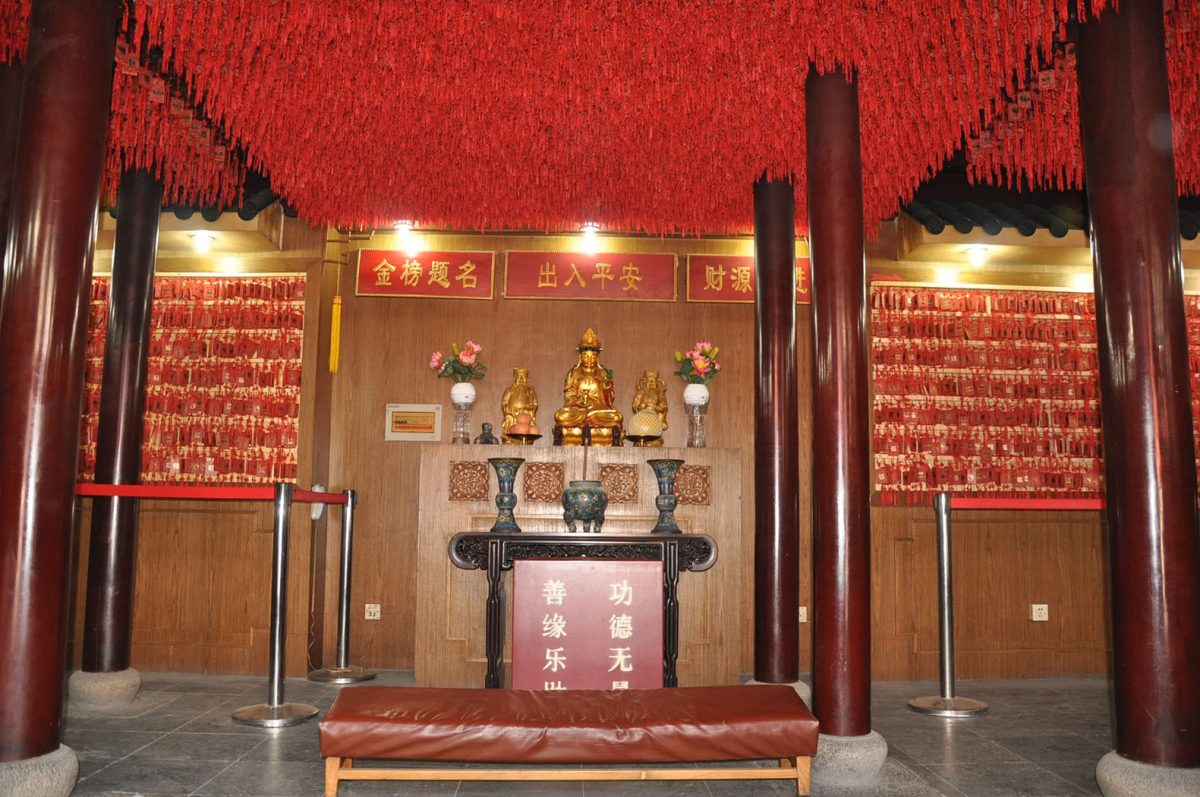
您的右面还有一个祈福堂。进门以后,你会看见房顶和墙壁上挂满了一块块小红牌。小红牌上有信众书写的名字和祈祷的愿望。祈福堂正面悬挂有三块匾额,它们是“财源广进”、“出入平安”和“金榜题名”。
信众祈祷的内容大致就是这三个方面的内容,有的祈祷健康平安,有的祈祷生意兴隆、财源茂盛,有的祈祷金榜题名、考试和就业顺利等等。道士每天早晚都会到祈福堂念经。一年以后会将祈福牌焚化,上奏神灵,保佑信众的愿望实现。
the Chapel of Wishes
The building on your right is the Chapel of Wishes. Coming into the Chapel, you’ll see roof and walls covered by little red plates, on which people wrote their names and wishes. At the front of the Chapel of Wishes, there are three plaques, one dealing with wealth, one with peace and the other, one with academic achievement.
These are exactly what most people ask for: some pray for safety and health; some pray for business prosperity; others pray for great academic achievements. Taoists would recite the scripture every morning and night at the Chapel of Wishes. The Taoist burn the plates at the end of the year and people’s wishes therefore are sent to heaven.
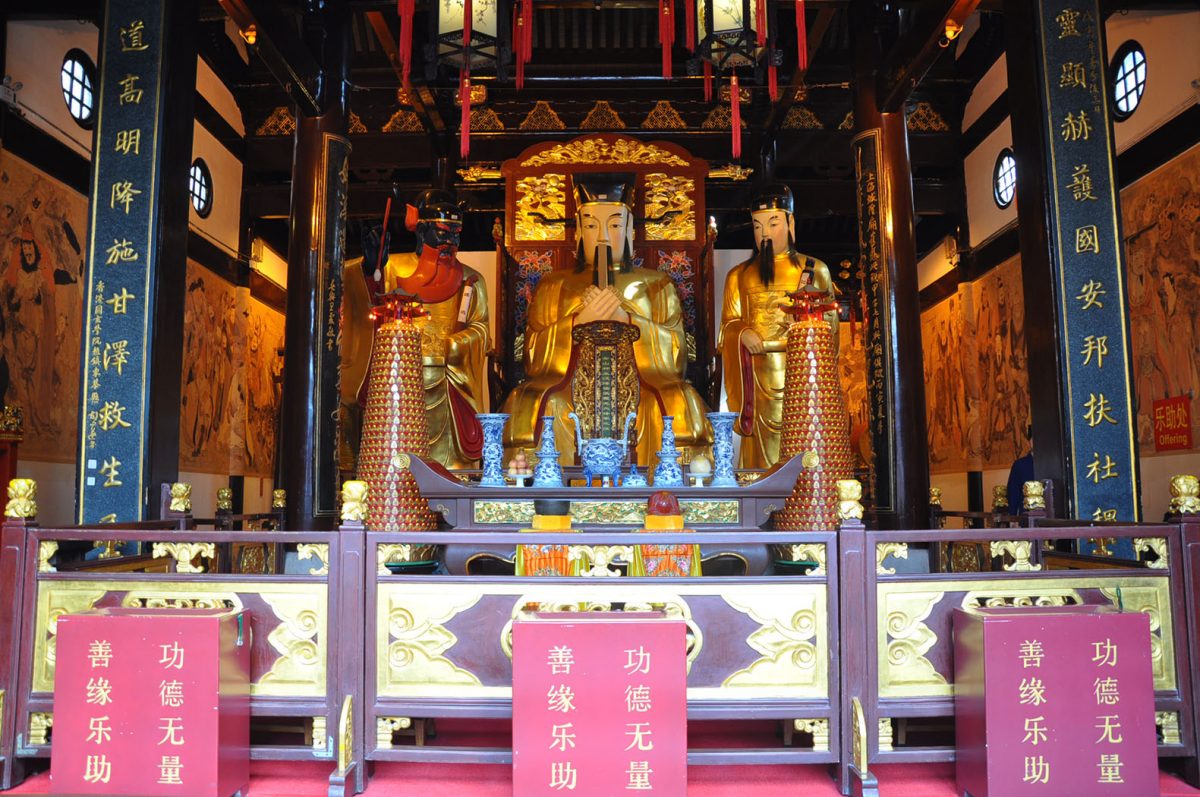
在进入城隍庙大殿前,请您注意在门上边有一块匾额,上面写着“城隍庙”三个大字。大字是由已故的中国人民政治协商会议副主席赵朴初书写的。门的两旁有一副著名的对联。这副对联是清代秀才莫秉清写的。
- 上联是:做个好人,心正身安魂梦稳。
意思是,如果您能够做一个好人,那么,你的思想是正当的,你的身体也是平安的,即使睡觉也是睡得安稳的。 - 下联是:行些善事,天知地鉴鬼神钦。
意思是,如果你能够做好事善事,那么天神是知道的,地神是明白的,所有阴世的鬼和天上的神都会敬佩您。
这副对联就是教化信众做人要做好人,做事要做好事。做了好人好事,自己心安理得,天地都会知晓。结果会有好的报应。
城隍庙的大殿供奉的主神是金山神主霍光。霍光是汉代的大臣、政治家,曾经为汉武帝辅政。据记载,上海在受到倭寇侵扰金山的时候,由于霍光保佑,倭寇被打退,金山人民免受战火灾难,于是,百姓建造了金山庙,供奉霍光。金山庙改为城隍庙以后,霍光仍然作为上海的守护神,得到奉祀。
霍光神像前,二边有二位官吏。一位是白脸的文判官,记录人的善事好事,掌管善鬼;一位是黑脸的武判官,记录人的恶行坏事,掌管恶鬼。
大殿二侧,各有一名值日巡行功曹,一名是日巡,负责白天巡逻。一名是夜巡,负责晚上巡逻。
大殿二侧,还各有四名皂吏,共计八名。二名是值日受事,二名是值日传事,二名是奏事,二名是行事皂吏。他们分别负责接受事务、传达事务、上奏事务、办理事务。
上海城隍神主管上海的人和事。如果人做了好事或者坏事,巡行功曹就会记录下来,报告给判官。好事由文判官记录,坏事由武判官记录。到了天年已尽的时候,城隍神就会对亡魂总算账。功大于过的,进入福堂,逍遥自在。过大于功的,就进入地狱,接受冤怼报应。
在大殿里挂有匾额。匾额是由已故的上海图书馆馆长著名书法家顾廷龙先生书写的。匾额有四个字:“牧化黎民”,意思是城隍神管理和教化着普通的老百姓。大殿还有二副对联。前面一副是1994年以后新做的,是由香港圆玄学院赵镇东先生捐助的。
上联是:威灵显赫,护国安邦扶社稷。意思是,城隍神有威武显赫的灵验,保护国家,安定百姓,帮助祖国江山。
下联是:圣道高明,降施甘泽救生民。意思是,城隍神按大道高明行事,普降甜美的雨露,拯救苦难的百姓。
里面的一副是城隍庙原有的,由民国时期上海有名的慈善家、书法家王震(即王一亭)书写的。
上联是:刻薄成家,难免儿孙浪费。意思是,如果你在创立家业的时候残酷剥削他人,那么,即使你创业成功,也保不住你的儿孙挥霍浪费,将家业败坏干净。
下联是:奸淫造孽,焉能妻女清贞。意思是,如果你犯下奸淫之罪,造成了冤孽,那么,你怎么能够保证你的妻子和儿女也保持清白和贞节呢?
这二副对联,一是颂扬城隍神的丰功伟绩,一是劝人要忠厚宽恕,清正廉洁,不要犯下残酷剥削和奸淫妇女的罪错。
大殿周围墙上有著名画家戴敦邦绘制的壁画:《群仙欣会图》。《群仙欣会图》绘制了100名以上的道教神仙。其中有三清(即元始天尊、灵宝天尊和太上老君)、玉皇大帝、斗母元君、三官大帝、四海龙王、财神赵公明、关帝、文昌帝君、八仙、张天师等等。道教神仙欣喜地聚会在一起,庄严肃穆。戴敦邦的壁画继承了永乐宫元代巨型壁画的传统,又具有线条粗犷,浓彩重墨,神情逼真,栩栩如生的艺术风格。人们在大殿欣赏这副壁画的时候,无不感到仙气环绕,众神护佑。
City God Temple
Before going into the grand hall, you can see a plaque on the gate with the name “City God Temple”. This is written by Zhao Puchu, former vice chairman of the National Committee of the Chinese People’s Political Consultative Conference. The couplet here, be written by scholar Mo Bingqing of the Qing dynasty, are quite famous. It says:
Be a good person, and hence win mental and physical health;
Do decent things, hence win the respect of the gods.
The couplets here shows the common aspect of Taoism: it teaches people to be decent in simple words and promised them rewards.
The main deity of the grand hall is Jin Shan God Huo Guang, as Shanghai was originally named as Jin Shan, which means Golden Mountain. Huo Guang was a government official and a politician from the Han Dynasty. Huo used to serve Emperor Hanwu the Great. According to the record, when the pirates attacked the Golden Mountain at Shanghai, the Chinese army were able to drive them away under Huo’s protection. The local residents built the Golden Mountain Temple in memory of Huo; when the temple was renamed City God Temple, people still offered sacrifices to Huo, who guards Shanghai as a City God.
In front of Huo’s statue, there are two assistant officials: the one with the white face records the good things people have done and take charge of the good ghosts; the black-faced one records the bad things people have done, taking charge of the bad ghosts.
On each side of the grand hall, there’s a patrol officer: one patrol in the day, the other one at night. There are also four officers on each side of the hall. Two of them take down information and requests; two of them transfer the information; two give the information to the City God; two deal with the response.
The City God of Shanghai takes care of the Shanghai residents and their progenies. His officers will take record of people’s behaviors and then report to the two main officers. White assistant officer keeps records of the good things, while his black comrade keeps records of the bad things. When people die, City God will be involved for the judgment. Those whose beneficences outweigh their sins are sent to heaven to receive all the rewards; those whose evildoings outweigh their kind deeds are dispatched down to hell to be punished.
The plaque hanging in the grand hall is written by former Shanghai Library manager, calligrapher Gu Tinglong. It says“to shepherd the people”, meaning the City God takes charge and teaches the local residents. There are also two couplets in the grand hall. The one on the front was written after 1994, donated by Zhao Zhendong of the Hong Kong Yuen Xuan Institute. It reads:
The gods protect the people and bring harmony and peace to the country;
The gods follows the wise path, deposit sweet rain to the land and save the people.
The couplet inside has been at City God Temple for a long time. It is written in the time of the Republic of China, by the famous Shanghai philanthropist and calligrapher
Wang Zhen. The couplet reads:
If you gather your wealth by exploiting others, your children will devour your wealth;
If you commit adultery, others will do the same to your wife and daughter.
This couplet serves as a paean for the glory of the City God as well as a warn against committing crimes.
The paintings on the walls are the works of famous artist Dai Dunbang. The name is “A Happy Gathering of the Deities.” It has more than 100 Taoist deities in it, including San Qing, the Taoist trinity which is the highest and absolute truth of the universe, and Yu Huang, the Jade Emperor who is the Lord of the world; and Mother Dou Mu, who is the mother of all the stars on the heaven; and Emperors of Sky, Land and Water who are in charge of the daily records of people’s behavior on the earth; and Dragon Kings of the four oceans who in charge of the raining and snow; and God of Wealth; God of War (or Lord Guan); God of Literature (Wen Chang) who in charge of all the academic issues; and Master Zhang the founder of religious Taoism. These Taoist deities are gathering together with delight. It’s a sacred picture. Dai’s painting inherits the tradition of the grand paintings at the Yong Le Palace of the Yuan Dynasty. It has strong lines, rich colors, and the god’s expressions are vivid. Standing in the grand hall with eyes fixed upon the painting, you’ll feel surrounded by the gods in a celestial atmosphere.
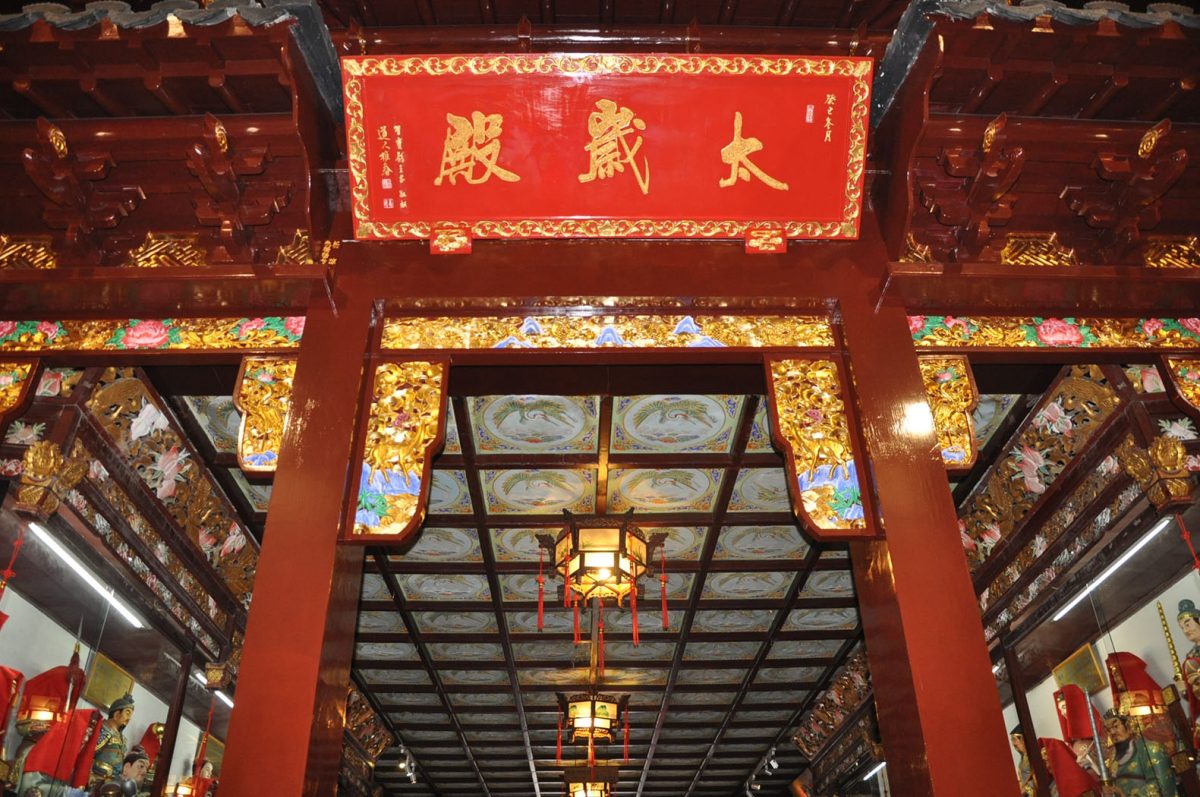
现在我们来到了元辰殿。元辰殿供奉的是六十位太岁神。太岁神是太岁星神。中国人以天干地支来纪年,以六十个干支为一个循环。天上有六十个太岁星,因此,就有六十位太岁神。每位太岁神都分管当年的运势,也分管当年出生的人的运势。太岁神是同每个人的命运直接有关的神灵。
上海城隍庙为了方便信众寻找自己的本命太岁。六十位太岁按照十二生肖排列。因此,如果你是属牛的,你可以首先找到标签为牛的五位太岁神。然后再根据自己的出生年份,找到自己的本命太岁。
太岁神都曾经在不同的朝代降生到人间。因此,他们都有姓名,都有忠于祖国、守卫疆土、清正廉洁、勤奋好学、路不拾遗、隐逸终生等好的品质,都是人生的楷模。
每年春节期间,都有大批信众来到上海城隍庙,祭拜太岁神,祈求本命太岁和值年太岁护佑平安,延寿消灾。
Yuan Chen Hall
Now we are at Yuan Chen Hall, the hall with 60 Taisui Deities, or Deities of Annual Stars. In the traditional Chinese calendar, 60 years is a cycle, so there are 60 Taisui Stars on the sky, meaning there are 60 Taisui Deities in our world, each in charge of a year’s fortune and the fortunes of people who are born in this year. That’s why Taisui Deities is directly related to people’s destiny.
To make it easier for you to find your Tuisui, City God Temple has arranged the 60 Deities according to the 12 animal zodiacs. So if you re an ox, you can first fing the five Taisui Deities marked as ox, and then find your own Taisui Deitie based on the year you were born.
Taisui Deities had their human avatars born to the earth to save people in different dynasties, so the statues here are the figures of all of their avatars in their human names. Some serve their countries; some protect their lands; some are curious and diligent; some are equitable and just. All are role models to people in this world.
During each Spring Festival, people swarm to the City God Temple to visit the Taisui Deities, ask their own Taisui and the Taisui of the year for protection and long life.
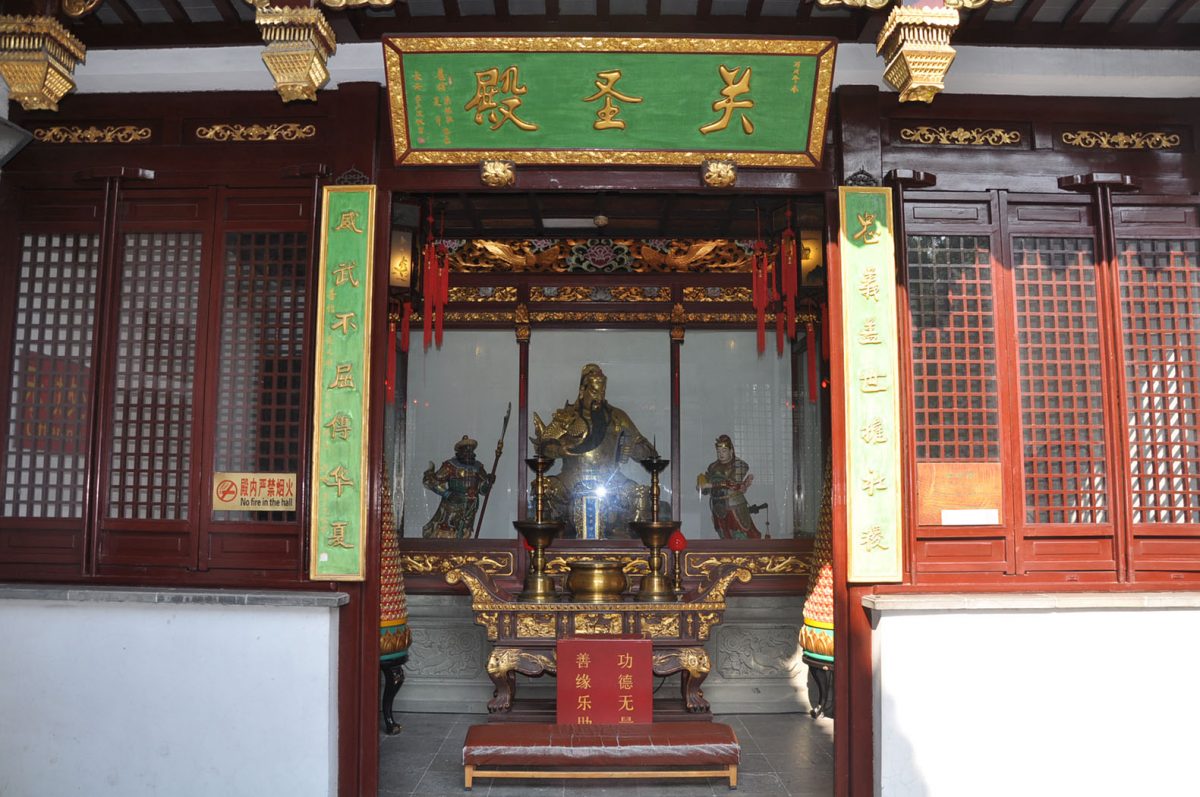
走过元辰殿,我们进入上海城隍庙的第二进,也就是城隍殿前的天井。
- 天井的左边是关帝殿。关帝殿前有一副对联。
上联是:忠义盖世护社稷。意思是关帝具有盖世无双的忠诚和仗义,守护着国家的安全。
下联是:威武不屈传华夏。意思是关帝威猛而决不背叛的品格,在华夏土地上世世代代传颂。
关帝殿正中供奉的是关帝。关帝就是三国时代名将关羽,又名关云长。二边是他的侍从周仓将军和他的义子关平。关羽的一生集中了忠孝节义等崇高美德,从宋代起受到历代皇朝的封赐。
关帝具有管理命禄、保佑科举、治病除灾、驱邪辟恶、诛罚叛逆、巡察冥司、庇护商贾、招财进宝的职能。
the Hall of the god of War
Passing the Yuan Chen Hall, we are at the second part of the City God Temple.
- Left to the courtyard is the Hall of the God of War, whose real name is Guan Yunchang, a famous military general in the time of the Three Kingdoms periods 2000 years ago and well known for his loyalty and justice, people regarded him as a good after his death. The hall has got a couplet in front, which says:
The General Guan, with his loyalty and justice, protects the country;
His mighty name is spread for generations on this land.
Right in middle of the hall sits the statue of General Guan. Beside Guan are his adjutant General Zhou Cang and his adopted son Guan Ping. As a general, Guan was loyal to his emperor; as a son, he was obedient to his parents; as a decent man, he was honest to himself; as a leader and a friend, he brought justice to the land. Form the Song Dynasty onwards, Guan was endowed with many titles from the Emperor and became more and more powerful in many different sectors, people nowadays pray to General Guan for their political, business and academic achievements, as well as for curing the ill, driving away evil, killing the traitorous and taking care of the dead.
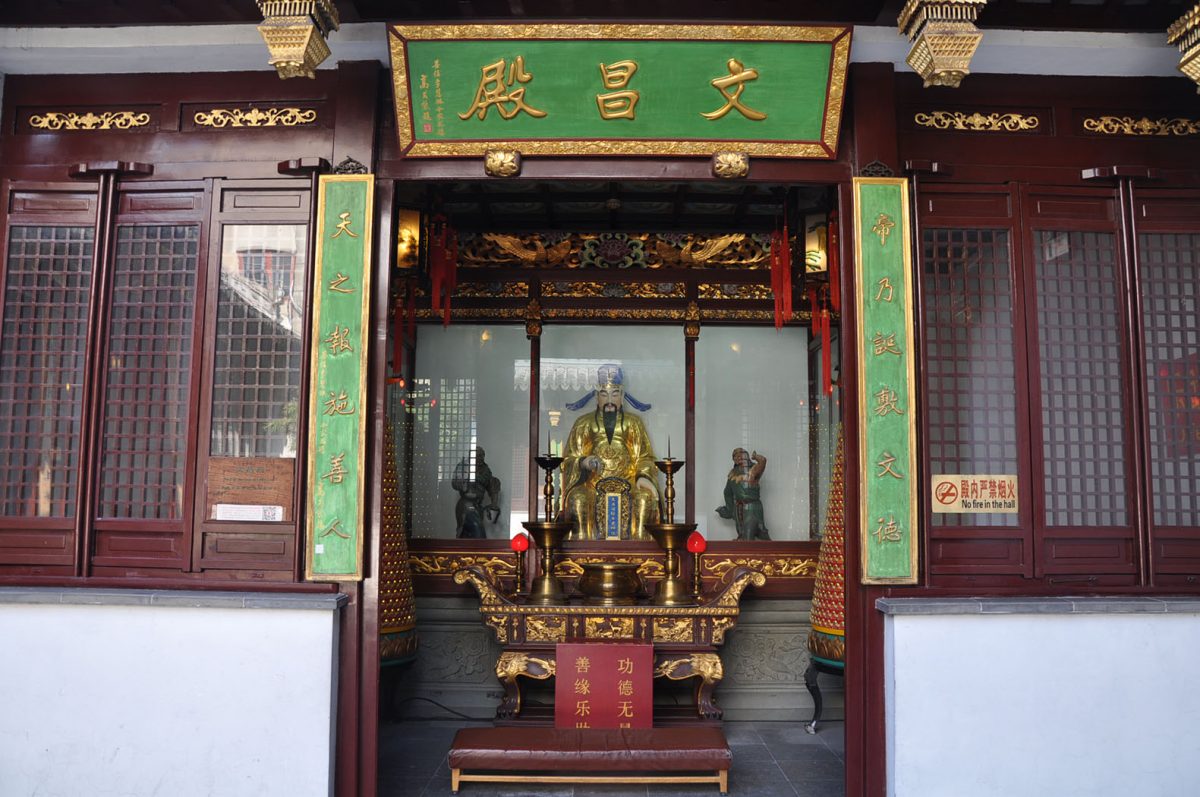
- 天井的右边是文昌殿。文昌殿前有一副对联。上联是:帝乃诞敷文德。意思是,文昌帝君主管的是有关文人的事务。下联是:天之报施善人。意思是:只要行善积德就会得到文昌帝君的报应。文昌殿正中供奉的是文昌帝君,即梓潼帝君。二边是他的侍从天聋和地哑。据说这二位侍从决不会透露任何天机给祈求的人。
文昌帝君主管人的功名和禄位,因此做学问、写文章和参加考试的人都祭拜文昌神。现在,很多青年学生和学生家长在考试和求职的时候也来祭拜文昌帝君。
Wen Chang Hall
- On the right of the courtyard stands Wen Chang Hall. In front of the hall there is a couple, explaining to the visitors that Wen Chang Emperor is in charge of the literati. On doing good deeds, the literary man will be rewarded by Wen Chang. Wen Chang Emperor, or Zi Tong Emperor, sits in the middle of the hall; on his sides are his assistants, the Deaf and the Mute, who would never release any secrets about the examination to the people who pray for that.
Wen Chang Emperor is in charge of people’s examination which is directly related with their political career in the past, so the literati and the students all come to him for good luck. Till today, many young students and their parents still pray to Wen Chang Emperor when they are taking exams or accepting interviews.
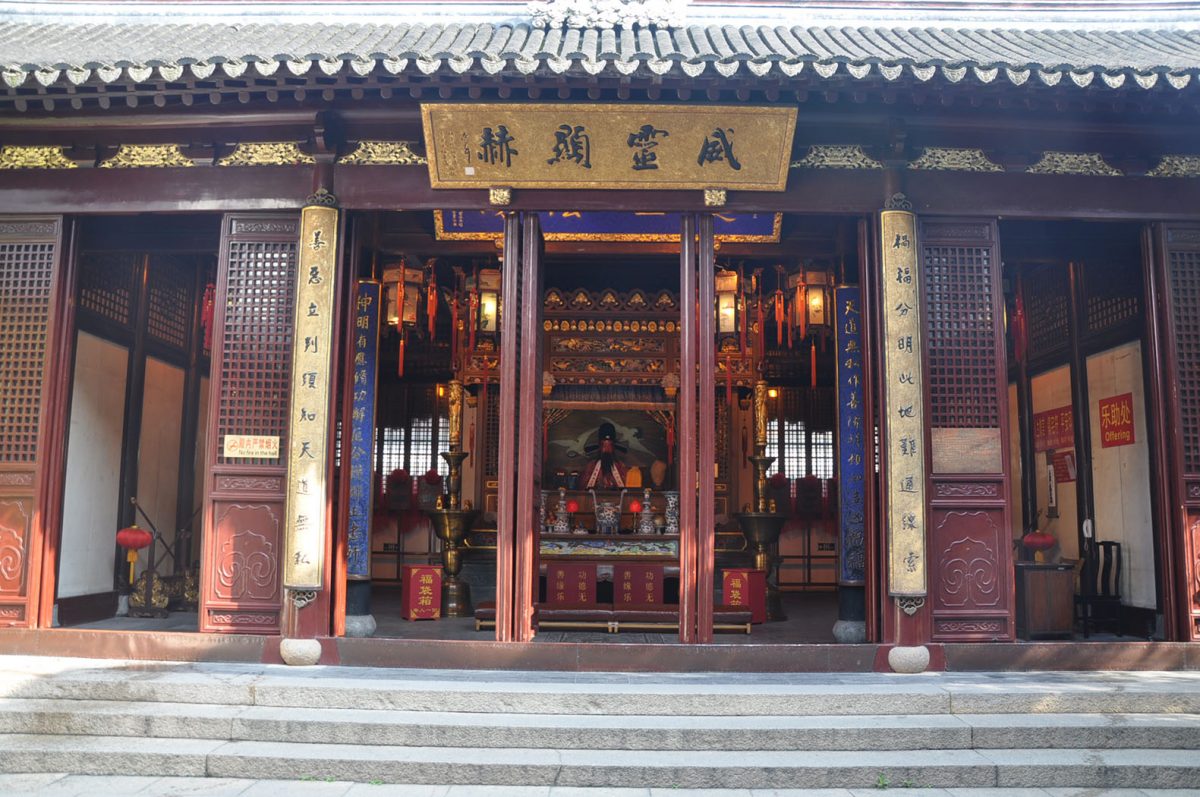
天井的正面就是城隍殿。城隍殿供奉的就是明代敕封的上海县城隍秦裕伯。秦裕伯神像按照明代官吏的服装雕塑。头戴官帽,身穿官袍。在秦裕伯神像前面,是明代官府办公用的桌子。上面安放有笔墨、砚台、官印、令箭等。在桌子前面还有二个小童,小童手捧案卷,专为城隍神办公服务。
城隍殿的二侧,有大锣、行灯和香炉,旌节幢幡和十块警示牌。这些都是城隍神出行时的仪仗。大锣、行灯和香炉是为城隍神开道。旌节幢幡是为城隍神助威。十块警示牌中六块“上海县正堂”、“敕封显佑伯”、“加封护海公”,用来表明城隍神的身份。四块“肃静”、“廻避”告示沿路民众要肃静、让路。
城隍殿有二副匾额和对联。
- 前面的一副,匾额是“威灵显赫”,颂扬城隍神具有显赫而威武的灵验。匾额由著名书法家潘景季书写。
- 上联是:祸福分明,此地难通线索。意思是,灾祸和福分到了城隍神前面是清清楚楚分得明白的,任何人到了这里想开后门、行贿买通都是不可能的。
- 下联是:善恶立判,须知天道无私。意思是,是善还是恶,在这里立刻可以判定,你要知道城隍神行的是天道,那是大公无私的。
这副对联将城隍神掌判人间善恶的职能,大公无私的品格,写得清楚明白,给行善的人以鼓励,给作恶的人以威慑。
后面的一副,匾额和对联都是由香港青松观捐助。匾额是“燮理阴阳”,意思是城隍神管理着阴阳二个世界的事务,由著名画家程十发书写。对联是由书法家曹齐书写。
- 上联是:天道无私,作善降祥,预知吉凶祸福。意思是,天道是没有偏向的,做了好事的就会降下吉祥护佑,城隍神预先知道人间的吉凶祸福。
- 下联是:神明有应,修功解厄,分辨邪正恩奸。意思是神灵都是有感应的,只要你修持功德,就能够解除灾厄,城隍神清楚地分辨一切正确和邪恶,恩惠和凶奸。
城隍神秦裕伯,祖籍扬州,迁居上海。原来是元代的进士,曾经在山东和福建做官。为官清正,爱民如子,盗贼匿迹,深受百姓爱戴。元末弃官,隐居上海。明太祖登基以后,即召见起用秦裕伯。但是,秦裕伯几次回绝。直到明太祖亲自手谕,秦裕伯才入朝任侍制,深得明太祖的赏识,还出任主考官。
秦裕伯死后,被封为上海县城隍神。中国自古就有“有功于民者则祀之”的传统。因此,一些有功于国家和人民的人,在死后都得到人民的奉祀。道教是中国的宗教,也继承了这个传统。道教中有许多由人升为神的神灵,这体现了中国人不忘记祖先恩德的优良传统。
城隍殿的神龛全部由木雕组成,十分精致。神龛使用的花纹由牡丹花纹组成。牡丹,人称是中国的国花,雍容华贵。因为道教是中国的宗教,所以,同使用莲花为标志的来自印度的佛教不同。
每年农历二月二十一日是城隍神的圣诞日,上海城隍庙都要举行七天的圣诞祈福祈寿法会,举行隆重的祭拜城隍神的仪式。为信众提供寿面。庙前的戏台上要连续七天演唱娱神大戏。
城隍殿中间供奉的是上海县城隍神秦裕伯。在秦裕伯殿的左边有城隍娘娘殿,里面供奉的是城隍神秦裕伯的夫人儲氏。右边是育德殿,里面供奉城隍神秦裕伯的父母,俗称老爷和太太殿。每年农历三月二十八日是城隍夫人圣诞日,上海城隍庙都要举行为城隍夫人换衣祭祀活动。来自上海各方的信众都来恭贺城隍夫人圣诞。在庙里唱歌舞蹈,热闹异常。城隍娘娘殿和育德殿神龛也都是木雕组成,上面雕刻有凤凰、仙鹤和鹿的图案,精美异常。
the City God Hall
City God Hall faces the courtyard. In the hall, we have the Shanghai City God Qin Yubo, who was deified in the Ming Dynasty, which is why his statue is dressed in the uniform of Ming Dynasty government officials with a hat and a robe. In front of Qin’s statue, there’s desk which you could usually find in a government in Ming Dynasty, on which lies a brush, an inkstone, an ink bar, an official seal and an arrow of order on top of it. Two assistants stand in front of the desk with files in their hands, ready to tend to the business of the City God.
On both sides of the City God Hall, you can see gongs, lanterns, incense burners, flags and 10 warning signs, which are used in City God’s procession. The gongs, lanterns, incense burners are in the front, clearing out the way for the god; the flags show his position and his glory, six of 10 warning signs, including “Shanghai County Sheriff”, “Xian You Comte” and “Duke patron of the Sea” refer to the City God’s status, while the other four signs, including “Silence” and “Aside” tell passengers to keep silent as well as leave room for the City God’s team entourage.
There are two plaques, along with two pairs of couplets, at the City God Hall.
The plaque in the front, written by the famous calligrapher Pan Jingji, says “prestige in glorious fame”. The couplets say the god can tell right from wrong, good from evil, so that everyone who comes here shall receive proper judgment with no chance of escape.
The plaque and couplets in the back are donated by Ching Chung Taoist Association of Hong Kong. The plaque, written by the famous artist Cheng Shifa, says the City God manages issues in both the world of the living and the world of dead; the couplets, written by calligrapher Cao Qi, say the gods have no bias, so the good people will receive protection. Even if disaster lies in your way, there always remains a chance of steering away from it by performing kind deeds.
City God Qin Yubo was originally from Yangzhou, and then moved to Shanghai. As an imperial Scholar, he used to take government positions in Shandong and Fujian provinces. He loved the people as his own children, so the people loved him back. In his jurisdiction, there was no thief around. Qin resigned from his post at the end of Yuan Dynasty to live in Shanghai. When the first Emperor of Ming Dynasty ascended to the throne, he asked for Qin; however, Qin turned him down several times until the emperor sent a hand-written letter. Qin then took a position in the central government. Favored by the Emperor, he once presided over a national exam. After Qin died, he was entitled the City God of Shanghai County. The Chinese tradition is to confer the title of god to a dead person who has high reputation by serving the public; so many people with accomplishments were deified posthumously. Taoism, a Chinese religion, also has inherited the tradition by the deification of many, an indication of people’s remembrance of their ancestor’s achievements.
City God Hall’s exquisite, peony-patterned shrines are all works of delicate wood sculpture. The resplendant and elegant peony is the national flower of Chine. Taoism as a Chinese religion, uses peony, while Buddhism originally from India, uses lotus as its sign.
Annually February 21st of Lunar Calendar is the nativity of the City God, when the taoists would hold a seven-day ritual to pray for peace and harmony, during which they would provide long-life noodles to the public who attend the ceremony. In the opera stage of the temple, there will be seven days of performance for the gods.
City God Qin Yubo sits in the middle of the City God Hall; on his left is the Hall for Qin’s Lady, a hall dedicated to Qin’s Lady Chu; on his right is the Parents Hall, which is dedicated to Qin’s parents. On March 28th of Lunar Calendar, which is Lady’s birthday, ceremony would be held for “changing the clothes” in which the old clothes of statue would be replaced by the new ones offered to the Lady. People from all over Shanghai would come to congratulate the Lady, singing and dancing in the temple. The shrines of the goddess and parents are also made of wood, with patterns of phoenix, heron and deer on it.
技术支持 奥谷信息技术 ( 上海 ) 有限公司 / Support by: aoGUU Information Technology
